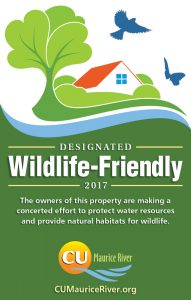The Maurice River Watershed has remarkable water quality, abundant open space, and plentiful biodiversity: no small feat for a region in America’s most densely populated state. However, poor land-use practices can compromise the health of the watershed.
When the workings of a watershed are impaired, it causes serious problems:
- flooding
- water shortages
- surface run-off
- soil erosion
- change in water flow
- water contamination
- invasion by exotic plants
- loss of habitat
- property damage from storm surges
The condition of streams and rivers is a reflection of the diverse land uses within the watershed. Land management decisions made on residential properties ultimately impact the health of the entire river basin and community. Poor land use leads to dirtier water, less water, and damaged habitats, while good land use has positive impacts on:
- water quality
- water regeneration
- healthy habitat
 This Wildlife-Friendly Designation Application recognizes residents who implement best management practices. Awardees are making a concerted effort to promote healthy habitat in the Maurice River Watershed by reducing the amount of water they withdraw from the Kirkwood-Cohansey Aquifer and minimizing the quantity of non-point source pollution stemming from their property. They also manage their property to create a stopover or link for wildlife between preserved natural areas. These stewards accomplish this by providing a natural landscape that supports native plant communities and offers wildlife these three essentials: food, shelter, and water.
This Wildlife-Friendly Designation Application recognizes residents who implement best management practices. Awardees are making a concerted effort to promote healthy habitat in the Maurice River Watershed by reducing the amount of water they withdraw from the Kirkwood-Cohansey Aquifer and minimizing the quantity of non-point source pollution stemming from their property. They also manage their property to create a stopover or link for wildlife between preserved natural areas. These stewards accomplish this by providing a natural landscape that supports native plant communities and offers wildlife these three essentials: food, shelter, and water.
Respond "yes" or "no" to whether you have included the actions from the following list into your management routine.
- Each yes answer is the equivalent of one stewardship point, while no responses represent opportunities to expand on your best management practices.
Applicant Name(s)
Property Address
City
E-mail
Phone